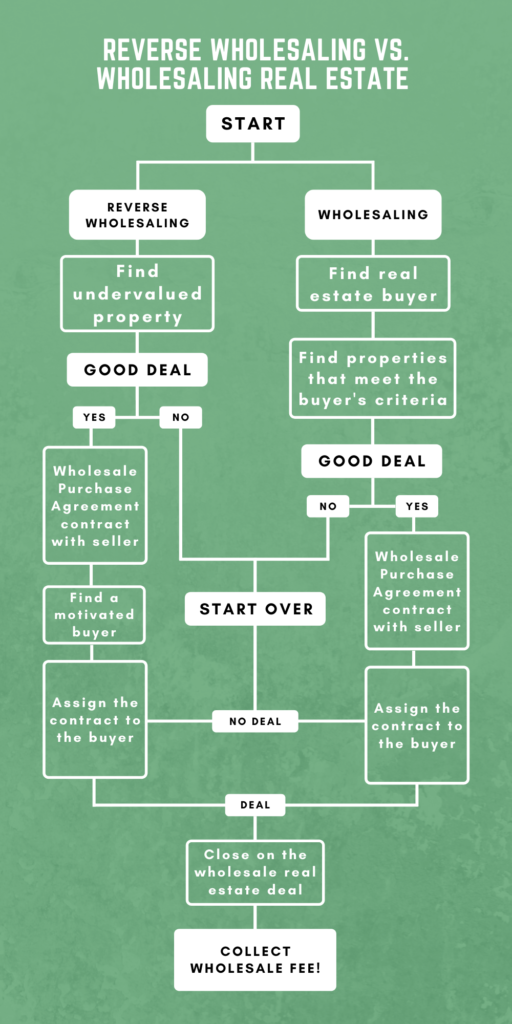If you’re interested in wholesaling real estate properties it’s important to know the differences between reverse wholesaling and wholesaling. Both can be very profitable but approach wholesaling from different angles.
Two Approaches to Wholesaling Real Estate
There are basically two ways to approach wholesaling real estate: To be a “buyer finder” or to be a “property finder”. Both of these approaches offer excellent opportunities for revenue generation. Both methods require little to no capital investment for the wholesaler.
Wholesaling refers to finding a property first before locating a buyer for it.
Reverse wholesaling involves lining up buyers first, then finding (sourcing) properties to wholesale to them.
Reverse wholesaling and wholesaling achieve the same outcome of matching real estate buyers and sellers.
How Does Real Estate Wholesaling Work?
Click this link for a complete run down of how wholesaling houses works.
Real estate wholesalers generally seek out distressed houses for sale — properties selling for less than market value because the seller wants to unload quickly. Reasons can include divorce, health problems, an impending foreclosure, inheriting an unwanted property, a rental trashed by a vacating tenant, squatters in the property, etc.
Here are the high level steps:
Step 1: Source Properties. Wholesalers source properties directly from the owners using a variety of tactics, such as “bandit” signs, newspaper ads, canvassing neighborhoods, websites, mailers, etc.
Step 2: Sign a Wholesale Purchase Agreement With the Seller. Once the wholesaler finds a seller looking to get rid of their property, he or she signs a Wholesale Purchase Agreement with the seller. This agreement grants the wholesaler the exclusive right to find a buyer at or above a specified price within a defined time period. For example, “Wholesaler shall find a cash-only buyer at or above $125,000 within 30 days of the signing of this Agreement.”
Step 3: Find a Cash Buyer. Once the wholesaler has a signed contract, he or she will then seek out a quick cash buyer. This usually entails contacting a number of investors looking to buy properties for cash that they can rehab and rent or flip. Once a buyer is found at or above the specified price, the wholesaler transfers (“assigns”) the purchase contract to that buyer in exchange for a wholesaler’s fee or a spread between the sale and purchase price.
The wholesale transaction is structured so that the wholesaler makes a profit from matching the seller and buyer without the wholesaler having to put up any capital.
Advantages of Wholesaling
Real estate wholesaling is appealing because unlike fixing and flipping houses, you don’t have to finance, purchase or bear any renovation costs on a property. You find properties, get them under contract, then find a buyer and arrange for the buyer and seller to meet.
Disadvantages of Wholesaling
The biggest challenge (particularly in a hot market) is locating and getting distressed properties under contract. Finding sellers willing to part with their houses in a short time at a discounted price can be tough. This is complicated by having to estimate a price to the seller that’s attractive to an investor once the wholesaler’s fee, renovation costs and title costs are added.
The second challenge for real estate wholesalers is finding a cash buyer for the house by the specified deadline. As a wholesaler you can put a lot of expense and effort into finding a property, convincing the owner to sell, and negotiating a Wholesale Purchase Agreement. If the wholesaler cannot find a cash buyer by the expiration date, the entire deal will fall through.
How Does Reverse Wholesaling Real Estate Work?
Many experienced real estate wholesalers agree that the biggest challenge can be finding a cash buyer who can afford the property and wants to close on it quickly.
Reverse wholesaling addresses this issue by first finding the right buyer, then locating suitable properties that meet the needs of that buyer.
Reverse wholesalers usually develop relationships with a small number of repeat “deep pocket” buyers. The wholesaler knows ahead of time each buyer’s purchase criteria. This includes price range, location, property type, age, condition, and any “no-no’s” like tax liens.
As a reverse wholesaler, it is essential to understand how much each investor is willing to compromise. This lets the wholesaler find and present several similar properties that fall within the buyer’s scope. This can significantly increase the transaction “close rate”, netting the wholesaler more profits and keeping deep pocket repeat buyers happy.
Advantages of Reverse Wholesaling
Reverse wholesaling requires less time and effort to find distressed houses before a deal can occur. Reverse wholesalers usually find properties by contacting wholesalers that already have distressed properties under contract and are looking for cash buyers. This leads to quicker deals and greater income for the reverse wholesaler.
Reverse wholesaling allows you to diversify your wholesaling business by working with different investors in different markets across the country. You may have a local buyer looking for rental houses in one location, and a private investment fund looking for multi-tenant properties in ten different cities. Your role is to find wholesalers in those markets with properties to sell. This approach can smooth out your cash flows and allow you to focus on more markets with a larger number of deals.
Disadvantages of Reverse Wholesaling
Reverse wholesalers must spend significant time and effort to identify and earn the trust of deep-pocket investors. These investors must be actively buying properties and have reasonable expectations. Many investors will only be looking in specific geographic areas, or have stringent property type or condition requirements. You need to work within the boundaries of what your buyers want.
Another challenge of reverse wholesaling occurs when the supply of distressed real estate rises. As distressed properties become more abundant, it becomes easier for investors to find them without third party assistance. This can result in the wholesaler getting cut out of the market.
Finally, wholesale real estate deals can fall through for a number of reasons. The seller might suddenly dig in and refuse to sell. An unexpected mechanic’s lien or even fraud can show up at the last minute. In these cases, a reverse wholesaler can end up with an unhappy client if a major deal doesn’t go through.
Comparing Reverse Wholesaling vs. Wholesaling
Although they are quite similar in function, wholesaling and reverse wholesaling real estate operate differently. Here are the key differences.
| Feature | Wholesaling | Reverse Wholesaling |
| Distressed properties | X | X |
| No capital required | X | X |
| Focuses on sellers first | X | |
| Focuses on buyers first | X | |
| Transactional / one-off deals | X | |
| Relationship-driven / repeat deals | X |

In a Nutshell
Real estate wholesaling and reverse wholesaling are excellent, proven strategies requiring low capital investment with the potential for high returns. They simplify the house flipping process for the wholesaler by removing the need to finance and purchase real estate directly.
If you’re primarily interested in finding distressed properties and working with property owners to find buyers quickly, then wholesaling is for you.
If you’re primarily interested in working with deep-pocket investors looking for multiple properties in different locations, then reverse wholesaling is for you.
Hopefully, this comparison of reverse wholesaling vs. wholesaling helped you decide which approach is better for you.
Back to Wholesaling Houses | NEXT: Wholesaling Houses Case Study

